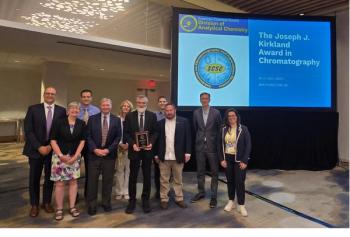
- LCGC Europe-06-01-2008
- Volume 21
- Issue 6
Method Transfer Problems
What do you do when the method can't be reproduced?
As I write this, I have just finished a week of teaching a liquid chromatography (LC) training class in Chongqing, China. On the last day, we spent several hours looking at problems that the students brought to class, and it reminded me how chromatographers worldwide encounter the same type of problems. One problem that came up was related to the transfer of a method from one instrument to another. This kind of problem is one that all of us encounter at one time or another, so I would like to dedicate this month's "LC Troubleshooting" instalment to method transfer problems.
The Rule of One
It is strange how we automatically apply the scientific method to most of our work in the laboratory, but somehow we discard it when it comes time to troubleshoot an LC problem. For troubleshooting purposes, I summarize the recommended technique as the of One". This reminds us to change just one variable at a time when investigating a problem.
Often a problem goes something like this: We notice that something is wrong with the chromatogram, so we replace the column. There is a guard column in use, so we might as well change it, too. Then we observe that the mobile phase reservoir is almost empty, so we make up a new batch of mobile phase. Then we look at the clock and see that it is almost quitting time, so there's no way we will get a run started before going home. We use the extra time to change the pump seals, because it is about time for the periodic service of the pump. The next morning we come to work and start up the system. It works great! But the same problem happens again the next week — are we going to repeat all the same changes? By changing one thing at a time, it often takes longer initially to identify the problem source, but with additional knowledge about the system, we will be able to solve the problem much more quickly the next time.
Restrict the Differences
In one method, I observed that the separation changed noticeably when the method was moved from one instrument to another in the same laboratory. It is easy to assign the difference to the instrument, but is this the only variable that has changed? Often it is not. For example, in the present instance, the original method was developed on a two-pump high-pressure mixing LC system in which the mobile phase was prepared by on-line mixing. In the new instrument, a single-pump system was used with manual mixing. The same brand and model of column was used and the same temperature was set on the column oven, but, although we assume these conditions are identical to the original conditions, they might not be.
In a situation such as this, I prefer to further restrict the variables, if possible. First, make up a batch of hand-mixed mobile phase and run it on the original system. Then take the same bottle of mobile phase and the same column and move it to the second system. Now are the results the same? Look at the retention times. If they differ between the two systems, one possible cause is that the temperature of the column is different. For reversed-phase methods, retention changes by approximately 2% per each degree Celsius. If the ovens are calibrated differently, this can account for the difference. Often a change in temperature will change the relative retention between two peaks. Estimate the amount of change in temperature necessary to result in the retention difference. Now adjust the oven setting to see if this will correct the problem.
Whereas, in isocratic runs, a difference in flow-rate will affect the retention time of all peaks by the same proportion, so relative retention will stay the same. The pump flow-rate is easy to check. Just use a 10 mL volumetric flask and measure how long it takes to fill the flask for each system. You can determine quickly if there is a difference in flow-rate.
Mobile Phase Preparation
If we assume that the previously discussed experiment using the same column and mobile phase resulted in the same separation on both systems, we can break down the problem into smaller parts. Try the hand-mixed mobile phase with the original and new column on a single system. If the separations are the same, the columns are equivalent. With today's high-purity, type-B silica columns, column-to-column variation is much less probable than it was 10–15 years ago when high-purity columns were not so common, but sometimes column-to-column differences are seen.
Next, try the method using the same column on the two-pump system, but compare hand-mixed with on-line-mixed mobile phase. This is often the source of a difference in retention between two LC systems. For example, in one experiment in my laboratory, we found that a 50:50 buffer–acetonitrile mobile phase that was mixed by hand gave longer retention times than the same mobile phase mixed on-line from buffer (A-solvent) and acetonitrile (B-solvent). We adjusted the system controller to try other mixtures until we were able to obtain the same retention time as the hand-mixed instance. For one instrument, it required a setting of 48:52 buffer–acetonitrile to get the same retention times as a 50:50 buffer–acetonitrile mobile phase prepared by hand.
On-line mixing can be complicated further by solvent compressibility on mixing. For example, with methanol–water mobile phases, a mixture of 60–65% methanol occupies approximately 3.5% less volume than it should based upon the volumes mixed together. Similar acetonitrile–water mixtures are approximately 2% less in volume. It is easy to see that a high-pressure-mixing system can deliver a different actual mobile phase composition than a low-pressure-mixing system delivers. Two pumps calibrated to accurately deliver 100% water and 100% methanol, respectively, would deliver a 60% methanol mobile phase at a flow-rate approximately 3.5% lower than expected. Whereas, with low-pressure mixing, the mixture is prepared before the pump, and the pump will deliver the same calibrated volume whether pure solvents or a mixture is desired. Such differences are usually of little practical consequence for routine separations that have been tested adequately for robustness, but one should be aware of such sources of variability.
Dwell Volume Differences
The previous example used an isocratic mobile phase, but method transfer can be much more difficult with gradient methods if you do not take the system dwell volume into account. The dwell volume is the system volume from the point the solvents are mixed until they reach the column inlet. This results in an unintentional isocratic hold at the beginning of each gradient run. Differences in dwell volume between LC systems are often the single most common reason that gradient methods are difficult to transfer. A detailed discussion of dwell volume and method transfer was presented in an earlier "LC Troubleshooting" column.1 On a gross level, retention times are shifted by the difference in dwell time (the time it takes to flush out the dwell volume) on two systems, but early peaks in the chromatogram often exhibit differences in peak spacing as well as retention. There are some ways to compensate for differences in dwell volume,2 but these are much easier to apply if one develops the method so that such changes can be made easily.
Injection Volume
If peak heights or peak areas differ between the nominally identical method run on two different LC systems, another possible cause might be a difference in injection volume. In my experience, today's autosamplers are very precise — often with imprecision of <0.5% for 5–10 μL injections, but the accuracy might not be as good. There are two methods of injection: filled-loop and partially filled-loop injection.3 In the first, the volume of the injector loop dictates the volume of sample that is injected. If you purchase a loop of a defined volume, such as 20 μL, it should be expected to be the correct volume. However, the filling characteristics can be misleading because of the laminar flow profile of the sample moving through the sample loop during the filling process. The result is that for maximum accuracy, the loop should be over-filled by two- to three-fold to ensure that the loop is filled completely with sample, and the same volume (for example, 60 μL for a 20 μL loop) should be used each time. When the injector is operated in the partially filled-loop mode, a specific volume of sample is metered into a loop of larger volume. For example, 20 μL might be placed in a 100 μL loop. The accuracy of this volume is controlled by the filling device (usually a motorized syringe). However, because of laminar flow, accuracy will be best with a partially filled loop if the volume is less than half the loop volume (for example, <50 μL in a 100 μL loop). Thus, a nominally identical filled-loop injection or a >50% partially filled-loop injection can deliver different sample volumes to the column on two different LC systems.
It is most common to design an LC method so that the same volume of sample and standard is injected. In such instances, small differences in injection accuracy between two systems is of little concern as long as the injection precision (repeatability) is satisfactory.
Detector Differences
Another possible difference between two LC systems can reside with the detector. Most UV detectors in use today have automatic wavelength calibration built in to the power-up procedure, so it is unlikely that there will be a difference in the detection wavelength between two systems (unless the wrong wavelength is selected). Differences in detector flow-cell volume and time-constant settings can influence peak width, and, thus, peak height. For detectors in which the LC mobile phase is modified or removed, such as evaporative light scattering detection (ELSD) or LC–mass spectrometry (MS), the detector interface conditions can influence detector response, as can other detector settings.
Conclusions
If we consider all the possible differences between LC systems, it is not surprising that small differences in the chromatogram are commonly observed when a method is moved from one system to another, even if they are the same brand and model of instrument. Usually the differences are easier to track down if the two instruments are in the same laboratory. When the method is transferred to a different laboratory, method differences can arise from laboratory procedural differences as well as instrument differences. It is important to know that each system is performing at an acceptable level so that system performance is not a consideration in method transfer problems. For this reason, I recommend that a periodic system performance qualification test (such as described in reference 4) be performed for each LC system on a semiannual or annual basis. Once we know that the system is working as expected, we can break the problem down into smaller pieces. Try to minimize the number of unintentional changes that are made when transferring a method from one LC system to another. When you have identified the source of the differences between systems, you can usually modify the system or method such that you get acceptable results from each LC system.
Because of the myriad possible small differences between LC systems, a method will be much easier to transfer if it is designed as a robust method. Robustness testing involves making small, intentional changes in the method to see how the chromatogram is affected. For example, vary the percentage of organic solvent in the mobile phase by ±2%, the column temperature by ±5 °C, the mobile phase pH by ±0.2 units and so forth. When you know what influence each variable has on the results, it will be much easier to identify possible problem sources and to make small adjustments to the method so that it produces satisfactory results.
"LC Troubleshooting" editor John W. Dolan is vice president of LC Resources, Walnut Creek, California, USA; and a member of the Editorial Advisory Board of LCGC Europe. Direct correspondence about this column to "LC Troubleshooting", LCGC Europe, Advanstar House, Park West, Sealand Road, Chester CH1 4RN, UK.
Readers can also direct questions to the Chromatography Forum at
References
1. J.W. Dolan, LCGC Eur., 19(6), 336–343 (2006).
2. L.R. Snyder and J.W. Dolan, High Performance Gradient Elution (Wiley, New York, 2007), pp. 163–168.
3. J.W. Dolan, LCGC Eur., 14(5), 276–283 (2001).
4. G. Hall and J.W. Dolan, LCGC Eur., 15(10), 646–650 (2002).
Articles in this issue
over 17 years ago
Do's and Don'tsover 17 years ago
Event Newsover 17 years ago
Method Transfer in HPLCover 17 years ago
Digital Updateover 17 years ago
Comparison Techniques for HPLC Column Performanceover 17 years ago
What Does Good Laboratory Practice (GLP) Mean?over 17 years ago
Seeing GreenNewsletter
Join the global community of analytical scientists who trust LCGC for insights on the latest techniques, trends, and expert solutions in chromatography.





